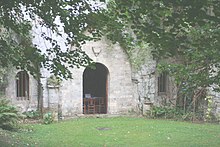| Revision as of 21:51, 24 March 2023 editKINGHB190 (talk | contribs)Extended confirmed users1,498 edits →Conteville and Sainte-Mère-ÉgliseTags: Reverted Mobile edit Mobile app edit Android app edit← Previous edit | Revision as of 21:52, 24 March 2023 edit undoKINGHB190 (talk | contribs)Extended confirmed users1,498 edits Undid revision 1146438254 by KINGHB190 (talk) Something strange happened with the textTags: Undo Mobile edit Mobile app edit Android app editNext edit → | ||
| Line 12: | Line 12: | ||
| ==Conteville and Sainte-Mère-Église== | ==Conteville and Sainte-Mère-Église== | ||
| No contemporary record provides the parentage for Herluin,<ref name="hollister">{{cite book | title=Domesday Studies; Novocentenary Conference: Papers | first=C. Warren | last=Hollister | chapter=The Greater Domesday Tenants-in-Chief | page=235 | publisher=Boydell & Brewer | year=1987 | isbn=0-85115-477-8}}</ref> although much later sources have assigned him parents (such as the otherwise unknown Jean de Conteville (965) and Harlette de Meulan). Herluin was a lord of moderate income and some land on the south side of the river ]. He was viscount of ], probably so created by his stepson, and held the ] of ], a portion of the ]. There he founded ] around 1050 with his son ].<ref>Freeman 1902, p. 112 and 382</ref> | |||
| ==Uncertain Parentage== | |||
| No contemporary record provides the parentage for Herluin,<ref name="hollister">{{cite book | title=Domesday Studies; Novocentenary Conference: Papers | first=C. Warren | last=Hollister | chapter=The Greater Domesday Tenants-in-Chief | page=235 | publisher=Boydell & Brewer | year=1987 | isbn=0-85115-477-8}}</ref> although later sources, notably the ], have assigned him parents such as the otherwise unknown Jean de Conteville (965) and Harlette de Meulan. | |||
| ==Herluin's marriage to Herleva== | ==Herluin's marriage to Herleva== | ||
Revision as of 21:52, 24 March 2023
Stepfather of William the ConquerorHerluin de Conteville (1001–1066), also known as Harlowen de Burgo, was the stepfather of William the Conqueror and the father of Odo of Bayeux and Robert, Count of Mortain, both of whom became prominent during William's reign. He died in 1066, the year his stepson conquered England.
| Herluin de Conteville | |
|---|---|
| (Harlowen de Burgo) | |
 Grestain Abbey in Normandy, the burial place of Herluin de Conteville. Grestain Abbey in Normandy, the burial place of Herluin de Conteville. | |
| Spouse(s) | Herleva, Fredesendis |
| Children | Odo of Bayeux, Robert, Count of Mortain, Isabella de Burgo, Emma de Burgo, "Muriel" de Burgo |
Conteville and Sainte-Mère-Église
No contemporary record provides the parentage for Herluin, although much later sources have assigned him parents (such as the otherwise unknown Jean de Conteville (965) and Harlette de Meulan). Herluin was a lord of moderate income and some land on the south side of the river Seine. He was viscount of Conteville, probably so created by his stepson, and held the honour of Sainte-Mère-Église, a portion of the county of Mortain. There he founded Grestain Abbey around 1050 with his son Robert.
Herluin's marriage to Herleva
In the mid-11th century, Conteville and its dependencies appear to have been in the hands of Herluin, whose wife Herleva was previously the mistress of Robert I, Duke of Normandy and mother of his only son, William, (later called William the Conqueror). Herluin and Herleva had two sons, Odo or Eudes, who became Bishop of Bayeux, and Robert, Count of Mortain. Both were prominent in the reign of their half-brother William. They also had several daughters, including Emma, who married Richard le Goz, Viscount of Avranches, and one of unknown name, sometimes called Muriel in modern genealogies, who married Guillaume, Seigneur de la Ferté-Macé. Herluin is said to have loyally borne William's body to his grave at Caen after he died in the burning of Mantes; however, that was in 1087, well after Herluin's death in 1066.
Herluin's marriage to Fredesendis
After Herleva's death, Herluin remarried to Fredesendis, who appears as a benefactor of Grestain Abbey, and as Herluin's wife in the confirmation charter of the abbey, dated 1189. The abbey was founded by Herluin himself around 1050, in hopes of achieving a cure to his leprosy or some similar disease. Little is known of the children of Herluin and Fredesendis. A son Jean de Conteville appears to have died young. A Ralph de Conteville appearing in the Domesday Book holding land in Somerset and Devon, has been identified as another son, though others derive that man from the Pas-de-Calais, and hence not of this family.
See also
References
- David Bates, Normandy before 1066, (Longman Group, 1982), 119.
- Freeman, Edward A. (1902). William the Conqueror. New York: The Perkins Book Company. p. 277
- Freeman 1902, p. 15.
- Hollister, C. Warren (1987). "The Greater Domesday Tenants-in-Chief". Domesday Studies; Novocentenary Conference: Papers. Boydell & Brewer. p. 235. ISBN 0-85115-477-8.
- Freeman 1902, p. 112 and 382
- (FR) Jean Dubuc, Histoire chronologique de la Normandie et des Normands: des origines à 1204, (Inédits et introuvables, 2003), 556.
- Freeman, Edward A., William the Conqueror (1902), p. 276-277
- ^ David C. Douglas, William the Conqueror (1964), p. 382
- The Normans in Europe, transl. & ed. Elisabeth van Houts, (Manchester University Press, 2000), 294.
- Jocelin of Wells:the making of a bishop in the reign of King John, Nicholas Vincent, Jocelin of Wells: Bishop, Builder, Courtier, ed. Robert William Dunning, (The Boydell Press, 2010), 14.
- Elisabeth van Houts, Domesday People, (The Boydell Press, 1999), 331
- Bates, David (1973) "Notes sur l'aristocratie normande: Hugues, évêque de Bayeux (1011 env. - 1049) et Herluin de Conteville et sa famille." Annales de Normandie 23 (1973): 7-38.